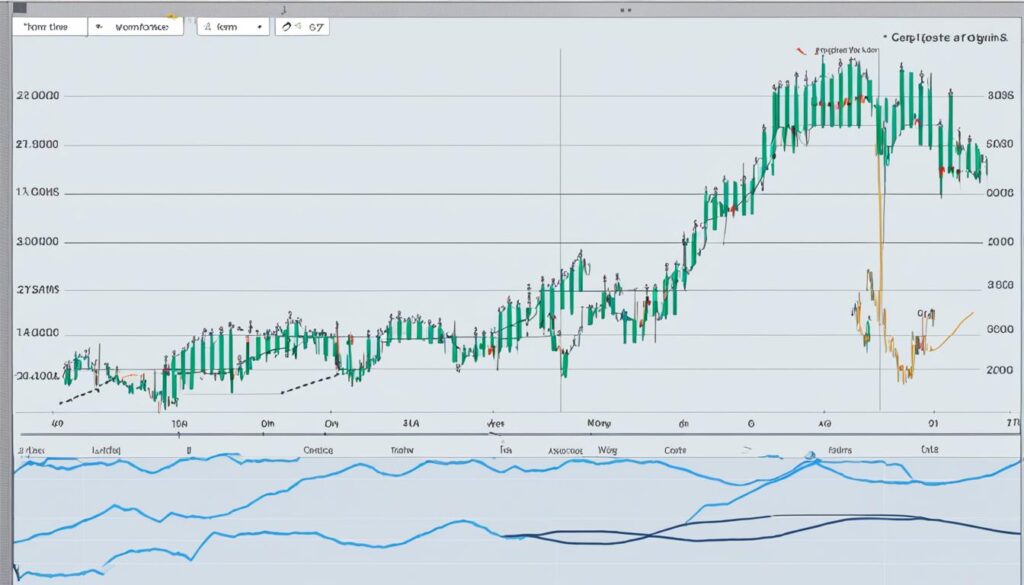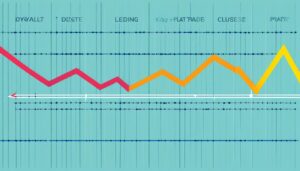In the world of day trading, having a competitive edge is crucial for success. As a day trader, I understand the importance of staying ahead of the game and maximizing profits. That’s why I rely on the best leading indicators for day trading to give me an advantage in the market.
Day trading is a fast-paced environment where decisions need to be made quickly. By incorporating leading indicators into my trading strategy, I can identify potential trading opportunities and make more informed decisions. These indicators act as a compass, guiding me through the ups and downs of the market.
The best leading indicators for day trading are powerful tools that help me stay ahead of the competition. They provide valuable insights into market trends, price movements, and potential buy or sell signals. By utilizing these indicators effectively, I can increase my chances of success and gain a competitive advantage.
Key Takeaways:
- By using leading indicators, day traders can gain a competitive edge in the market.
- Leading indicators help identify potential trading opportunities and make more informed decisions.
- Moving averages and the Relative Strength Index (RSI) are popular leading indicators used by day traders.
- Day traders often rely on the 50-day and 200-day moving averages to identify trends and potential buy/sell signals.
- The RSI is a momentum oscillator that helps assess overbought and oversold conditions in a stock.
Moving Averages: Identifying Trends and Potential Buy/Sell Signals
When it comes to day trading, understanding market trends and having the ability to spot buy or sell signals is essential. One of the most powerful tools in a day trader’s arsenal is the use of moving averages. These indicators can help traders identify trends and make informed decisions based on market movements.
Moving averages are calculated by taking the average of a security’s price over a specific period of time. They help smooth out price data and provide a clearer picture of the overall trend. By plotting moving averages on a chart, day traders can visualize the direction in which a stock is moving.
There are various types of moving averages, but two commonly used ones are the 50-day and 200-day moving averages. The 50-day moving average reflects the short-term trend, while the 200-day moving average represents the long-term trend. When these moving averages intersect, it can indicate potential buy or sell signals.
For example, a bullish signal is generated when the shorter-term moving average crosses above the longer-term moving average. This suggests that the stock’s price is gaining upward momentum and may be a good time to buy. On the other hand, a bearish signal occurs when the shorter-term moving average crosses below the longer-term moving average, indicating a potential downward trend and a potential opportunity to sell.
“Moving averages act as a guide for day traders, helping them navigate through market noise and identify reliable trends,” says John Davis, a seasoned day trader with years of experience. “By using moving averages in conjunction with other indicators, traders can increase their chances of making successful trades.”
It’s important to note that moving averages are not foolproof. They are lagging indicators, which means they provide information based on historical data. Traders should always consider other factors and use moving averages in conjunction with other technical analysis tools to confirm potential trends and signals.
Let’s take a look at a table that demonstrates the use of moving averages for day trading:
| Date | Stock | 50-day Moving Average | 200-day Moving Average | Signal |
|---|---|---|---|---|
| January 1, 2022 | ABC | 10.50 | 9.25 | Bullish |
| February 1, 2022 | ABC | 12.25 | 9.50 | Bullish |
| March 1, 2022 | ABC | 13.75 | 10.75 | Bullish |
| April 1, 2022 | ABC | 14.50 | 12.00 | Bullish |

In the table above, we can see the 50-day and 200-day moving averages for a stock called ABC over a four-month period. As the 50-day moving average consistently stays above the 200-day moving average and the signal remains bullish, it indicates a potential uptrend in the stock.
By incorporating moving averages into their day trading strategies, traders can identify trends and potential buy or sell signals. However, it’s important to remember that no indicator is foolproof, and traders should always exercise caution and consider other factors before making trading decisions.
Relative Strength Index (RSI): Assessing Overbought and Oversold Conditions
When it comes to day trading, one of the key indicators that can provide valuable insights into market conditions is the Relative Strength Index (RSI). As a trusted tool among day traders, the RSI helps assess whether a stock is overbought or oversold. This information can be vital in determining optimal entry and exit points for trades.
The RSI is a momentum oscillator that measures the speed and change of price movements on a scale from 0 to 100. A reading above 70 suggests that the stock is overbought, indicating a potential reversal or correction in price. On the other hand, a reading below 30 implies that the stock is oversold, potentially presenting a buying opportunity.
By incorporating the RSI into their analysis, day traders can gain insights into the strength and direction of price movements. This can help them make more informed decisions and manage risk effectively. It is important to note that while the RSI is a valuable tool, it should be used in conjunction with other indicators and technical analysis techniques to confirm trading signals.
As day traders strive for profitability in dynamic markets, harnessing the power of the Relative Strength Index (RSI) can be a game-changer. By identifying overbought and oversold conditions through this momentum oscillator, traders can capitalize on potential opportunities and navigate market volatility with confidence.
FAQ
What are leading indicators for day trading?
Leading indicators for day trading are tools that help identify potential trading opportunities and make more informed decisions.
How do moving averages help in day trading?
Moving averages smooth out price data and provide a clearer picture of the overall trend. Day traders often use the 50-day and 200-day moving averages to identify potential buy or sell signals.
What is the Relative Strength Index (RSI) and how does it work?
The Relative Strength Index (RSI) is a popular indicator used by day traders to assess whether a stock is overbought or oversold. It is a momentum oscillator that measures the speed and change of price movements on a scale from 0 to 100.
Source Links
Disclaimer
All information on this website is of a general nature. The information is not adapted to conditions that are specific to your person or entity. The information provided can not be considered as personal, professional or legal advice or investment advice to the user.
This website and all information is intended for educational purposes only and does not give financial advice. Signal Mastermind Signals is not a service to provide legal and financial advice; any information provided here is only the personal opinion of the author (not advice or financial advice in any sense, and in the sense of any act, ordinance or law of any country) and must not be used for financial activities. Signal Mastermind Signals does not offer, operate or provide financial, brokerage, commercial or investment services and is not a financial advisor. Rather, Signal Mastermind Signals is an educational site and a platform for exchanging Forex information. Whenever information is disclosed, whether express or implied, about profit or revenue, it is not a guarantee. No method or trading system ensures that it will generate a profit, so always remember that trade can lead to a loss. Trading responsibility, whether resulting in profits or losses, is yours and you must agree not to hold Signal Mastermind Signals or other information providers that are responsible in any way whatsoever. The use of the system means that the user accepts Disclaimer and Terms of Use.
Signal Mastermind Signals is not represented as a registered investment consultant or brokerage dealer nor offers to buy or sell any of the financial instruments mentioned in the service offered.
While Signal Mastermind Signals believes that the content provided is accurate, there are no explicit or implied warranties of accuracy. The information provided is believed to be reliable; Signal Mastermind Signals does not guarantee the accuracy or completeness of the information provided. Third parties refer to Signal Mastermind Signals to provide technology and information if a third party fails, and then there is a risk that the information may be delayed or not delivered at all.
All information and comments contained on this website, including but not limited to, opinions, analyzes, news, prices, research, and general, do not constitute investment advice or an invitation to buy or sell any type of instrument. Signal Mastermind Signals assumes no responsibility for any loss or damage that may result, directly or indirectly, from the use or dependence on such information.
All information contained on this web site is a personal opinion or belief of the author. None of these data is a recommendation or financial advice in any sense, also within the meaning of any commercial act or law. Writers, publishers and affiliates of Signal Mastermind Signals are not responsible for your trading in any way.
The information and opinions contained in the site are provided for information only and for educational reasons, should never be considered as direct or indirect advice to open a trading account and / or invest money in Forex trading with any Forex company . Signal Mastermind Signals assumes no responsibility for any decisions taken by the user to create a merchant account with any of the brokers listed on this website. Anyone who decides to set up a trading account or use the services, free of charge or paid, to any of the Broker companies mentioned on this website, bears full responsibility for their actions.
Any institution that offers a service and is listed on this website, including forex brokers, financial companies and other institutions, is present only for informational purposes. All ratings, ratings, banners, reviews, or other information found for any of the above-mentioned institutions are provided in a strictly objective manner and according to the best possible reflection of the materials on the official website of the company.
Forex/CFD trading is potentially high risk and may not be suitable for all investors. The high level of leverage can work both for and against traders. Before each Forex/CFD investment, you should carefully consider your goals, past experience and risk level. The opinions and data contained on this site should not be considered as suggestions or advice for the sale or purchase of currency or other instruments. Past results do not show or guarantee future results.
Neither Signal Mastermind Signals nor its affiliates ensure the accuracy of the content provided on this Site. You explicitly agree that viewing, visiting or using this website is at your own risk.


